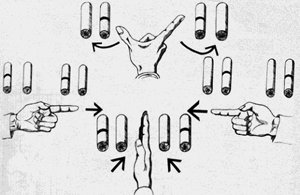MESSEKUCHE KUNEK - THE HANDGAME
Messekuche Kunek (The Handgame) for four or more players:
When anthropologist David Mandelbaum visited the Plains Cree in 1934, the
elders told him this game was taught by the Flathead tribe to those Cree
who took temporary refuge in the United States after the Rebellion of 1885.
Since then, it has evolved as the most popular gambling game among all tribes
in Saskatchewan.
The playing pieces consist of two bones or wooden cylinders.
One is marked with a cord or a ring of bark, the other is left plain. The
object is to find the unmarked piece; the other is to add confusion to the
game.
To further confuse and taunt the opposition, lively songs
are sung by the hiding team. The singers beat an accompanying rhythm to
their songs on a log placed before their team.
Traditionally, stakes included belongings such as a horse
or a coat. Wagers still take place between individuals; the stakes are always
of equal value. Long ago, if one man bet his tipi against another man's
clothing, they might agree that the tipi was worth five times as many points
as the clothes, so the man betting the clothing would have to win five games
to win the tipi, while the man wagering the tipi could win the clothing
in one game.

EQUIPMENT
- four small objects (two marked and two unmarked)
- 11 tally sticks
- a log placed before the players of each team or a hand
drum for each team
- 2 blankets placed over the knees of the players of each
side
- A 2" x 4" piece of wood, approximately 1 foot
long. This wood piece is called the "counting piece" as it holds
the tally sticks for each team. The stick must have 10 holes on either
side and one hole in the middle of each end.

HOW TO PLAY
- This is played between two teams consisting of four to
eight players each. The teams sit facing each other. A log is placed before
each team.
- The game begins using only one tally stick. The remaining
tallies are placed in the center to one side. Each group chooses a leader
to do the guessing. Taking turns, both leaders try to guess where the other
has hidden the unmarked piece. When one is right, the successful guesser
takes all four pieces and the one tally stick.
- The successful guesser chooses two men from his team
to hide the pieces. The leader of the opposing team may also ask someone
from his team to do the guessing at any time during the play. Each hider
receives one marked and one unmarked piece.
- The hiding team chants songs, keeping time by beating
the log. These songs, coupled with body movements, are to confuse their
opponents. Adding to the confusion are the hand movements behind their
backs or under the blanket. The guessing team watches closely, silently,
trying to detect any clues as to the whereabouts of the unmarked piece.
- To make a legitimate guess, certain specific hand signals
are used by the guesser. He must also shout "Ho!". Often a guesser
will tease the hiders by using a proper hand signal, but not shouting "Ho!"
which must be audible to indicate a guess. According to David Mandelbaum,
the hand gestures used to denote the arrangement of the pieces are as follows:
O = unmarked; X = marked |
ARRANGEMENT |
GESTURE |
RESULTS |
OXXO |
Thumb and index finger out stretched, other
fingers flexed. |
Correct guess; guesser's side takes both pieces
of bones. |
OXXO |
Index finger pointed to the right; all others
flexed. |
Guesser's side takes one pair of bones;
opponents score one point. |
OXXO |
Hand edgewise down middle. |
Guesser wrong; opponents score two points. |
XOOX |
Hand edgewise down middle. |
Correct guess; guesser side takes bones. |
XOXO |
Index finger pointed to right; all others
flexed |
Correct guess; guesser side takes bones. |
XOOX |
Thumb and index finger outstretched,
others flexed. |
Correct guess; guesser side takes bones. |
The guesser must remember to shout "Ho!"
each time a guess is made.

- If the guesser misses both unmarked pieces, the hider
wins two points and another turn. If the guesser is correct about both
unmarked pieces, his team receives both sets to hide. Should the guesser
find only one unmarked piece, the hiders receive one point and must hide
the remaining set until their opponents guess correctly. The hiding team
can win only one point a turn when they have only one set to hide. They
score only when the guessers are wrong.
VARIATIONS
Both of the following variations have to do with scoring.
In either case, the games go much more quickly.
- Each team can begin the game with half the number of
tally sticks.
- The people from Poorman's Reserve play the game using
more than one tally stick per score. If a man is confident of his guess,
he may wager three tally sticks. If he guesses correctly, he receives both
hiding pieces and scores three points. If he is incorrect, he loses all
three points
Click on one of these pictures to hear a traditional
handgame song sung by Edmund Bull at Wanuskewin Heritage Park. These songs would
serve as an accompaniment to the handgame.
Song 1 (1.2 MB) |
Song 2 (2.5 MB) |
 |
 |


